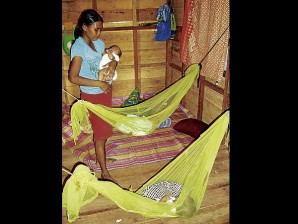Selflessness prevails in shelter plan

ANNALIZA Leban and her triplets, the first beneficiaries of the Catholic Relief Services shelter project. NICO ALCONABA
Annaliza Leban gave birth to Charlie, the first of the triplets, in this town on Nov. 27. That same day she was rushed to a hospital in Mati City to deliver, this time by Caesarean section, Charmaine and Charlene.
Annaliza and her babies were already home in Barangay Lambajon when Typhoon “Pablo” struck and wrecked this town on Dec. 4. Annaliza, her birth wounds still fresh, fell sick and had to be brought to the hospital again. The babies and six other siblings were left to the care of their father Danilo.
For months, while Annaliza fought for her life, the triplets, their six siblings and Danilo lived in a shanty built of what remained of their typhoon-swept house. On Feb. 11, Annaliza, now fully recovered, returned to Lambajon. This time, to a new house, courtesy of Catholic Relief Services (CRS).
Chosen by the people
The Lebans are the first beneficiaries of the group’s recovery and resilient shelter program for those who lost their homes during the typhoon.
The CRS built the Lebans’ 18-square-meter home for P21,000.
Fr. Darwey Clark, parish priest of Sacred Heart of Jesus Church, said the Lebans were chosen by the people of the community.
“When we were making the initial list of the beneficiaries, we asked the people who they thought should get the first shelter, they unanimously chose the Lebans,” Clark said.
“I was surprised at how easy it was for the residents, all of them victims of the typhoon, to choose the Lebans. It showed how selfless they were,” said the priest.
The selection process is not easy. The residents choose among themselves who needed shelter the most. The list will be validated by CRS. The names will be posted for public scrutiny.
Selflessness
In one community meeting, Clark said, a man asked that his name be deleted from the list, saying he could apply for a government loan and raise the money needed to rebuild his house.
“The man instead nominated someone who was not even in the meeting,” Clark said.
A beneficiary should have at least three persons who would help in the construction. This was not a problem for a blind man who got nominated.
“Also in one meeting, when the crowd was asked how the blind man would do his part of the deal (help in the construction), five neighbors stood up and volunteered to work,” Clark said.
Aside from the volunteers, CRS hires a carpenter and two helpers who will be paid P350 and P225, respectively, daily for 10 days.
“We expect this ‘10 working days’ to be cut in half because the workers, as the days go by, will automatically know how the lumber should be cut and where it should be installed. Even if they finish a house in only five days, they will be paid for 10 days,” Clark said.
The community volunteers, now with new skills, can also apply as “paid helpers” when demand for workers peaks. The CRS plans to go full blast, building at least 750 units, next month.
The shelters, however, are not the usual “A-type frames and braces” where galvanized iron sheets will be installed.
Special design
The CRS has a special design that would withstand a typhoon.
Roel Bansali, CRS shelter and quality assurance engineer, said coco lumber is being used.
Each unit would need at least 720 board feet of coco lumber, or a total of 10 coconut trees.
When CRS starts building more shelters next month, each 18-square-meter unit will only cost P14,000. But these won’t have walls.
From the savings of building “wall-less” shelters, Bansali said, more typhoon resilient structures will rise.
“We believe the people can look for ways to put a wall on their new shelter. They can use the tents and tarpaulins they got from donor agencies. They can use whatever they have salvaged from the typhoon debris,” Clark said.
This holds true for the Lebans. When the Inquirer visited their new home in Purok Uno in Lambajon, Danilo was sawing off a P300 plywood he bought from his earnings as carpenter’s helper, an occupation new to the coconut farmer which he learned while helping build his new home.
“I’m making a door,” he said, his wife Annaliza in a corner attending to Charlie, one of the triplets.
Inside their 18-square-meter, typhoon-resilient shelter, is the newly built wall that makes half of the house a bedroom.
The interior wall, now covered with a gray tarpaulin, is made of pieces of wood that Danilo picked up from the typhoon debris.














